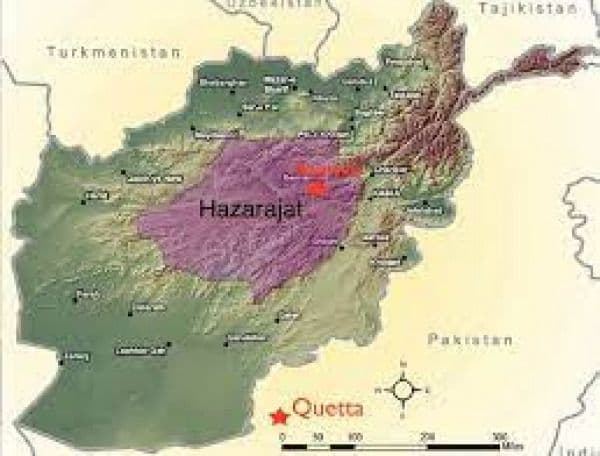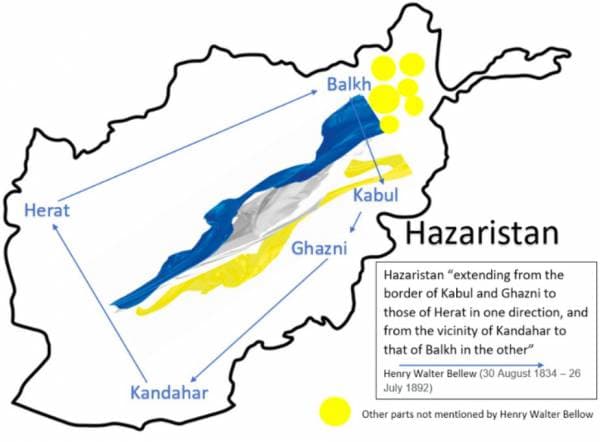Hazara Afghanistan
The Afghanistan we see on the map today was created by Afghan King Emir Abdur Rahman in 1900. Before 1880, the entire central region of Afghanistan constituted a different country that was known by the name Hazaristan or Hazarajat. It was not considered a part of Afghanistan.

That Afghanistan is a nation of Pashtuns, Tajiks, Hazaras, etc is just a modern notion created 50 years ago. Consider this Afghan idiom of the famous Pashtun poet Khushal Khattak(c. 1613 -1689 CE) - “An Afghan is a Pashtun and a Pashtun is an Afghan. Behead him who says otherwise”.
Hazaras are considered by historians to be descendants of Genghis Khan’s army. This is supported by their Asiatic features. Although a majority of Hazaras adopted Persian with their own Hazaragi dialect, some still speak a Turkic language known as “Moghul”. An overwhelming majority of Hazaras are Shia by faith, in contrast to their Sunni Pashtun neighbors. Hazaras are distinct from other Afghans linguistically, culturally, and ethnically. Traditionally, they inhabited the entire central region of Afghanistan from Ghazni to Herat.

That Hazaras were a distinct nation from Afghans is attested by Abul Fazl (c.16th century). Abul Fazl says-" Hazaras are the descendants of the army sent by Manku Khan(Grandson of Genghis Khan). Hazaristan spans from Ghazni to Qandahar and from Maidan to Balkh". - Ain I Akbari I.591
According to the US Dept of State, Hazaras today constitute 15% of Afghanistan’s population. However, these figures were disputed by Hazaras themselves who claimed that they were 25%. The UN Bonn conference (2001) estimated the Hazara population at 19%. Until 1880, Hazaras formed 67% of the population of today’s Afghanistan region.
Except for a few Hazara tribes residing in the vicinity of Kabul & Kandahar who paid annual tribute, the Hazaras were independent and not under the control of Pashtun (Barakzai) rulers of Afghanistan. Hazaras subsisted on cattle breeding. Made their living by taxing (& raiding) Silk Route caravans from India to Central Asia passing through Bamiyan. They were independent & divided into several tribes. An exceptional Hazara chief named Mir Yazdan Baksh (c.1800 CE) united them.
The rising Hazara power under Mir Yazdan Baksh could not be tolerated by Afghan king Dost Mohammad Khan. Khan invited Hazara chief to Kabul under the pretext of friendship. He assured safety under the Quran oath. In Kabul, the unsuspecting Hazara chief was arrested at the first opportunity. Yazdan Hazara had a prudent wife who had cautioned him about the treachery of Afghan Khan. But as the husband wouldn’t relent, she had also come with him. Afghan king decided to kill them. But by taking advantage of the king’s avarice & making false promises of tribute, they heroically escaped. This was an early Afghan attempt to subdue Hazaras. However,
Hazaras subjugation was carried to completion by an Afghan king named Abdur Rahman khan in 1888 CE. He was a Sunni extremist who believed in the complete extermination of the Shia and nonmuslims through ghastly punishments. In 1888, Abdur Rahman called for his first invasion against the Hazara country. He called for a Jihad and told the Pashtun tribes “heads will be mine and the property will be yours”. He jailed Hazara tribal leaders. A few Hazaras revolted but their rebellion was brutally crushed. It was Abdur Rahman Khan who first conquered almost all of the Hazara tribes. Between 1880-1891, he brought 60% of Hazara tribes under control.
The Afghan conquest of Hazaristan was extremely brutal. They used to marry Hazara women by force. Hazaras were forced to utter abuses at Imam Ali(venerated by Shias). Hazaras were subjected to extremely brutal punishments like burning genitάls with fire. Exorbitant taxes were charged. Hazaras tolerated everything for a while. One day, 33 Afghan soldiers rάped the wife of a Hazara in front of him. The Hazaras, preferring death to dishonor, decided it was enough & killed Afghan soldiers. Other Hazaras also joined and this snowballed into a major rebellion.
In response, Afghan king Abdur Rahman assembled Sunni religious leaders and declared a Jihάd on “godless Shias”. He promised Hazara land, Hazara wealth, and children as rewards of war. All Afghan tribes united under the Jihad. The Hazara revolt was brutally crushed. After the crushing defeat of Hazaras, they were enslaved. Hazara slaves became so cheap in Kabul that they could be brought for 10 seers of wheat. Hazaristan became part of Afghanistan.
Many refractory Hazara were forcibly deported from Hazaristan. They were sold as slaves in Kabuli. Today’s Kabuli Hazaras are their descendants. Hazaras could not bear the oppression. Many tribes migrated to British India(Quetta) where they form a large diaspora even today. Some Hazaras were forced to embrace the Sunni faith. Sunni mosques were built in Hazaristan. To counter Hazara’s numerical strength, Pashtun tribes were settled in Hazaristan. Hazara land was seized and given to Pashtun settlers. Many Hazaras migrated to Iran to escape persecution. Hazaras were banned from owning houses or weapons. Blood tax was imposed on Hazaras. Arable areas of Hazaristan were depopulated of Hazaras and given over to Pashtun nomads. More than half of the Hazara population was killed or forced out. Hazara women were made sex slaves. Some women preferred death over dishonor. In one incident in 1893, 47 Hazara women jumped off the cliff to avoid capture at the hands of Sunni Afghan soldiers. This incident has been in the Hazara memory and these women are honored even today.
Hence, in the Persian language, there is a saying “Sag e Afghan kas Dara adam e Hazarah nah” meaning that “Even a dog of Pashtuns has a protector but a Hazara does not”. A bridge in Kabul has the name “Pul e Yak Piasagi” meaning “The bridge of one paisa”. This was because at this place Hazara slaves were sold at one paisa. Until 1970, Sunni Pashtun Mullahs declared that killing a Hazara secures Allah’s favor. This was not just mere rhetoric. One Latif Ghul rαped and killed 40 Hazaras. Later he confessed several Mullahs told him that “pious acts” like Hazara killing absolved his previous sins.
It is against this background that the Taliban’s offensive against Hazaras has to be understood. “Hazaras are not Muslim, they are Shia. They are kuffar” — Mullah Manan Niazi, Taliban Governor. No wonder, then, that Hazaras have been a target in Pakistan and Afghanistan even today.
Sources: